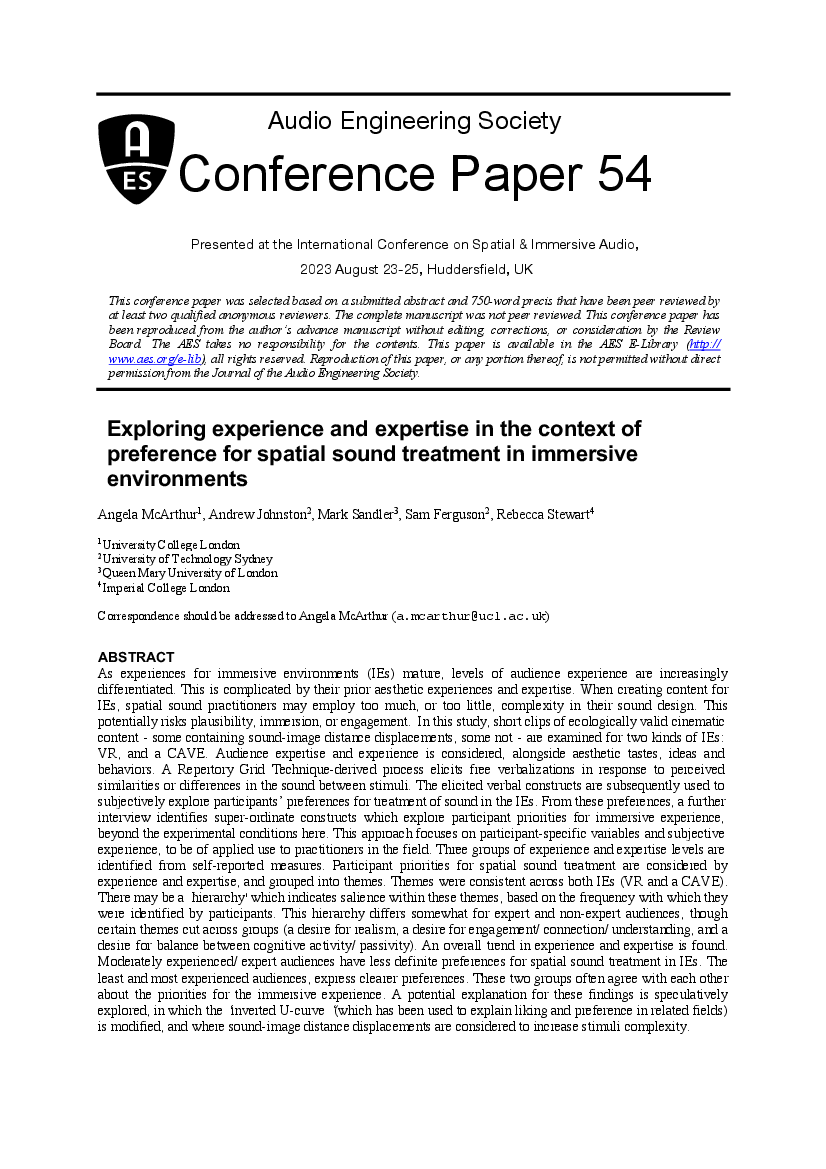Home / Publications / E-library page
You are currently logged in as an
Institutional Subscriber.
If you would like to logout,
please click on the button below.
Home / Publications / E-library page
Only AES members and Institutional Journal Subscribers can download
As experiences for immersive environments (IEs) mature, levels of audience experience are increasingly differentiated. This is complicated by their prior aesthetic experiences and expertise. When creating content for IEs, spatial sound practitioners may employ too much, or too little, complexity in their sound design. This potentially risks plausibility, immersion, or engagement. In this study, short clips of ecologically valid cinematic content - some containing sound-image distance displacements, some not - are examined for two kinds of IEs: VR, and a CAVE. Audience expertise and experience is considered, alongside aesthetic tastes, ideas and behaviors. A Repertory Grid Technique-derived process elicits free verbalizations in response to perceived similarities or differences in the sound between stimuli. The elicited verbal constructs are subsequently used to subjectively explore participants’ preferences for treatment of sound in the IEs. From these preferences, a further interview identifies super-ordinate constructs which explore participant priorities for immersive experience, beyond the experimental conditions here. This approach focuses on participant-specific variables and subjective experience, to be of applied use to practitioners in the field. Three groups of experience and expertise levels are identified from self-reported measures. Participant priorities for spatial sound treatment are considered by experience and expertise, and grouped into themes. Themes were consistent across both IEs (VR and a CAVE). There may be a ‘hierarchy` which indicates salience within these themes, based on the frequency with which they were identified by participants. This hierarchy differs somewhat for expert and non-expert audiences, though certain themes cut across groups (a desire for realism, a desire for engagement/ connection/ understanding, and a desire for balance between cognitive activity/ passivity). An overall trend in experience and expertise is found. Moderately experienced/ expert audiences have less definite preferences for spatial sound treatment in IEs. The least and most experienced audiences, express clearer preferences. These two groups often agree with each other about the priorities for the immersive experience. A potential explanation for these findings is speculatively explored, in which the ‘inverted U-curve ‘(which has been used to explain liking and preference in related fields) is modified, and where sound-image distance displacements are considered to increase stimuli complexity.
Author (s): McArthur, Angela; Johnston, Andrew; Sandler, Mark; Ferguson, Sam; Stewart, Rebecca
Affiliation:
University College London; University of Technology Sydney; Queen Mary University of London; University of Technology Sydney; Imperial College London
(See document for exact affiliation information.)
Publication Date:
2023-08-06
Import into BibTeX
Session subject:
Paper
Permalink: https://aes2.org/publications/elibrary-page/?id=22164
(988KB)
Click to purchase paper as a non-member or login as an AES member. If your company or school subscribes to the E-Library then switch to the institutional version. If you are not an AES member Join the AES. If you need to check your member status, login to the Member Portal.

McArthur, Angela; Johnston, Andrew; Sandler, Mark; Ferguson, Sam; Stewart, Rebecca; 2023; Exploring experience and expertise in the context of preference for spatial sound treatment in immersive environments [PDF]; University College London; University of Technology Sydney; Queen Mary University of London; University of Technology Sydney; Imperial College London; Paper 54; Available from: https://aes2.org/publications/elibrary-page/?id=22164
McArthur, Angela; Johnston, Andrew; Sandler, Mark; Ferguson, Sam; Stewart, Rebecca; Exploring experience and expertise in the context of preference for spatial sound treatment in immersive environments [PDF]; University College London; University of Technology Sydney; Queen Mary University of London; University of Technology Sydney; Imperial College London; Paper 54; 2023 Available: https://aes2.org/publications/elibrary-page/?id=22164
@article{mcarthur2023exploring,
author={mcarthur angela and johnston andrew and sandler mark and ferguson sam and stewart rebecca},
journal={journal of the audio engineering society},
title={exploring experience and expertise in the context of preference for spatial sound treatment in immersive environments},
year={2023},
number={54},
month={august},}
TY – paper
TI – Exploring experience and expertise in the context of preference for spatial sound treatment in immersive environments
AU – McArthur, Angela
AU – Johnston, Andrew
AU – Sandler, Mark
AU – Ferguson, Sam
AU – Stewart, Rebecca
PY – 2023
JO – Journal of the Audio Engineering Society
VL – 54
Y1 – August 2023